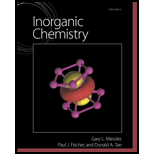
Inorganic Chemistry
5th Edition
ISBN: 9780321811059
Author: Gary L. Miessler, Paul J. Fischer, Donald A. Tarr
Publisher: Prentice Hall
expand_more
expand_more
format_list_bulleted
Question
Chapter 2, Problem 2.35P
Interpretation Introduction
Interpretation: The reason to explain maxima at 4 electrons and minima at 5 electrons in given figure should be explained.
Concept introduction:
Here electron affinity is positive thus reaction is endothermic in nature.
Expert Solution & Answer
Want to see the full answer?
Check out a sample textbook solution
Students have asked these similar questions
Please draw
9. compore the Following two Venctions IN
termy Of Ronction Rate and explan in
detail the reasoning that led to your conclusion
+He p₁₂ 11-
ㅐ 15
.. +He
H #H
H
/
H
b. Compare
the Following too reactions 14
terms of reaction Rate and explain in detail
the reasoning that led to your conclusion
Н
d-C-
tłu
Na
+2446
е
-ll +2n
"H
a.
•Write all of the possible products
For the Following ronction
А
-----
H
-
H
H
+ H₂0 H+
Н
b. in Rite the complete reaction Mechaniszn
For the Formation of each product.
·C. Suggest what Reaction conditions could
Result in each product being the major
Product of the veaction:
Chapter 2 Solutions
Inorganic Chemistry
Ch. 2.1 - Determine the energy of the transition from nh=3...Ch. 2.2 - Describe the angular nodal surfaces for a dz2...Ch. 2.2 - Prob. 2.3ECh. 2.2 - A third possible state for the p4 configuration...Ch. 2.2 - A nitrogen atom, with three 2p electrons, could...Ch. 2.2 - Calculate the effective nuclear charge on a 5s,...Ch. 2.2 - Calculate the effective nuclear charge on a 7s,...Ch. 2.3 - Explain why all three graphs in Figure 2.14 have...Ch. 2 - Determine the de Brogue wavelength of a. an...Ch. 2 - Using the equation E=RH(1221nh2) determine the...
Ch. 2 - The transition from the n=7 to the n=2 level of...Ch. 2 - Emissions are observed at wavelengths of 383.65...Ch. 2 - What is the least amount of energy that can be...Ch. 2 - Hydrogen atom emission spectra measured from the...Ch. 2 - The Rydberg constant equation has two terms that...Ch. 2 - For the 3pz and 4dxz hydrogen-like atomic...Ch. 2 - Repeat the exercise in Problem 2.7 for the 4s and...Ch. 2 - Repeat the exercise in Problem 2.7 for the 5s and...Ch. 2 - The 4fz(x2y2) orbital has the angular function...Ch. 2 - Prob. 2.13PCh. 2 - The label for an fz2 orbital, like that for a dz2...Ch. 2 - a. Determine the possible values for the l and ml...Ch. 2 - a. What are the values of quantum numbers I and n...Ch. 2 - a. At most, how many electrons in an atom can have...Ch. 2 - Determine the Coulombic and exchange energies for...Ch. 2 - Prob. 2.19PCh. 2 - Prob. 2.20PCh. 2 - What states are possible for a d3 configuration?...Ch. 2 - Provide explanations of the following phenomena:...Ch. 2 - Give electron configurations for the following:...Ch. 2 - Predict the electron configurations of the...Ch. 2 - Radial probability plots shed insight on issues of...Ch. 2 - Briefly explain the following on the basis of...Ch. 2 - Briefly explain the following on the basis of...Ch. 2 - a. Which 2+ ion has two 3d electrons? Which has...Ch. 2 - A sample calculation in this chapter showed that,...Ch. 2 - Ionization energies should depend on the effective...Ch. 2 - Prepare a diagram such as the one in Figure (a)...Ch. 2 - Why are the ionization energies of the alkali...Ch. 2 - The second ionization of carbon (C+C2++e) and the...Ch. 2 - Prob. 2.35PCh. 2 - Prob. 2.36PCh. 2 - The second ionization energy involves removing an...Ch. 2 - Prob. 2.38PCh. 2 - On the basis of electron configurations, explain...Ch. 2 - a. The graph of ionization energy versus atomic...Ch. 2 - The second ionization energy of He ¡s almost...Ch. 2 - The size of the transition-metal atoms decreases...Ch. 2 - Predict the largest and smallest radius in each...Ch. 2 - Select the best choice, and briefly indicate the...Ch. 2 - Select the best choice, and briefly indicate the...Ch. 2 - There are a number of Web sites that display...Ch. 2 - Prob. 2.47P
Knowledge Booster
Similar questions
- Write all of Me Possible Products For each Of the Following reactions. In each case identity all pains of enantiomers, all digsterzoners and all Meso compounds 9. 11-60 11-0-11 V-G Η Η H ~ C-11 +HB+ - 1 H b. पन्ना 171-0-11 H-C-H Н C-C=c-call +HBr Perendez ==arrow_forwardHow can i draw the mechanisms for this molecule?arrow_forwarda. Discuss and explain he difference IN Stability between the Chai and Boat Гольцу от судомехане b. For the Following Molecule draw both possible Clain conformations and explain which one is more stable and for what Reason. H. CH₂ CH₂ H "Harrow_forward
arrow_back_ios
SEE MORE QUESTIONS
arrow_forward_ios
Recommended textbooks for you
 Introductory Chemistry: An Active Learning Approa...ChemistryISBN:9781305079250Author:Mark S. Cracolice, Ed PetersPublisher:Cengage LearningChemistry: Matter and ChangeChemistryISBN:9780078746376Author:Dinah Zike, Laurel Dingrando, Nicholas Hainen, Cheryl WistromPublisher:Glencoe/McGraw-Hill School Pub Co
Introductory Chemistry: An Active Learning Approa...ChemistryISBN:9781305079250Author:Mark S. Cracolice, Ed PetersPublisher:Cengage LearningChemistry: Matter and ChangeChemistryISBN:9780078746376Author:Dinah Zike, Laurel Dingrando, Nicholas Hainen, Cheryl WistromPublisher:Glencoe/McGraw-Hill School Pub Co
 Chemistry: The Molecular ScienceChemistryISBN:9781285199047Author:John W. Moore, Conrad L. StanitskiPublisher:Cengage Learning
Chemistry: The Molecular ScienceChemistryISBN:9781285199047Author:John W. Moore, Conrad L. StanitskiPublisher:Cengage Learning General, Organic, and Biological ChemistryChemistryISBN:9781285853918Author:H. Stephen StokerPublisher:Cengage Learning
General, Organic, and Biological ChemistryChemistryISBN:9781285853918Author:H. Stephen StokerPublisher:Cengage Learning Chemistry & Chemical ReactivityChemistryISBN:9781133949640Author:John C. Kotz, Paul M. Treichel, John Townsend, David TreichelPublisher:Cengage Learning
Chemistry & Chemical ReactivityChemistryISBN:9781133949640Author:John C. Kotz, Paul M. Treichel, John Townsend, David TreichelPublisher:Cengage Learning

Introductory Chemistry: An Active Learning Approa...
Chemistry
ISBN:9781305079250
Author:Mark S. Cracolice, Ed Peters
Publisher:Cengage Learning

Chemistry: Matter and Change
Chemistry
ISBN:9780078746376
Author:Dinah Zike, Laurel Dingrando, Nicholas Hainen, Cheryl Wistrom
Publisher:Glencoe/McGraw-Hill School Pub Co


Chemistry: The Molecular Science
Chemistry
ISBN:9781285199047
Author:John W. Moore, Conrad L. Stanitski
Publisher:Cengage Learning

General, Organic, and Biological Chemistry
Chemistry
ISBN:9781285853918
Author:H. Stephen Stoker
Publisher:Cengage Learning

Chemistry & Chemical Reactivity
Chemistry
ISBN:9781133949640
Author:John C. Kotz, Paul M. Treichel, John Townsend, David Treichel
Publisher:Cengage Learning